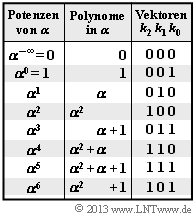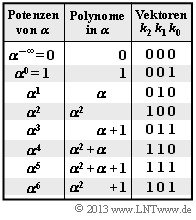Exercise 2.12Z: Reed-Solomon Syndrome Calculation
Wie in der Aufgabe 2.12 betrachten wir den Reed–Solomon–Code $(7, \, 4, \, 4)_8$, der auf dem Galoisfeld ${\rm GF}(q)$ mit $q = 8 = 2^3$ basiert. Die Grafik zeigt die zugehörige Umrechnungstabelle.
Gegeben sind die möglichen Codesymbole in Exponentendarstellung (Potenzen von $\alpha$) sowie in Polynom– und Koeffizientenvektordarstellung.
Vorgegeben ist das Empfangswort $\underline{y} = (\alpha, \, 0, \, \alpha^3, \, 0, \, 1, \, \alpha, \, 0)$. Anhand des Syndroms
- $$\underline {s} = (s_0, s_1, s_2) = \underline {y} \cdot { \boldsymbol{\rm H }}^{\rm T}$$
soll überprüft werden, ob einzelne Symbole des Empfangsvektors $\underline{y}$ bei der Übertragung verfälscht wurden. Gegeben ist hierzu die Prüfmatrix $\mathbf{H}$ des betrachteten Codes und deren Transponierte:
- $${ \boldsymbol{\rm H}} = \begin{pmatrix} 1 & \alpha^1 & \alpha^2 & \alpha^3 & \alpha^4 & \alpha^5 & \alpha^6\\ 1 & \alpha^2 & \alpha^4 & \alpha^6 & \alpha^1 & \alpha^{3} & \alpha^{5}\\ 1 & \alpha^3 & \alpha^6 & \alpha^2 & \alpha^{5} & \alpha^{1} & \alpha^{4} \end{pmatrix} \hspace{0.05cm},\hspace{0.4cm} { \boldsymbol{\rm H}}^{\rm T} = \begin{pmatrix} 1 & 1 & 1 \\ \alpha^1 & \alpha^2 & \alpha^3 \\ \alpha^2 & \alpha^4 & \alpha^6 \\ \alpha^3 & \alpha^6 & \alpha^2 \\ \alpha^4 & \alpha^1 & \alpha^{5} \\ \alpha^5 & \alpha^{3} & \alpha^{1} \\ \alpha^6 & \alpha^{5} & \alpha^{4} \end{pmatrix} \hspace{0.05cm}.$$
Hinweise:
- Die Aufgabe bezieht auf die Seite Schritt (A): Auswertung des Syndroms beim BDD des Kapitels „Fehlercodierung nach Reed–Solomon–Codierung”.
- Sollte die Eingabe des Zahlenwertes „0” erforderlich sein, so geben Sie bitte „0.” ein.
Fragebogen
Musterlösung
(1) Die entsprechende Gleichung zur Syndromberechnung lautet:
- $$\underline {s} \hspace{-0.15cm} \ = \ \hspace{-0.15cm} (s_0, s_1, s_2) = \begin{pmatrix} \alpha,0, \alpha^3,0, 1, \alpha,0 \end{pmatrix}\cdot \begin{pmatrix} 1 & 1 & 1 \\ \alpha^1 & \alpha^2 & \alpha^3 \\ \alpha^2 & \alpha^4 & \alpha^6 \\ \alpha^3 & \alpha^6 & \alpha^2 \\ \alpha^4 & \alpha^1 & \alpha^{5} \\ \alpha^5 & \alpha^{3} & \alpha^{1} \\ \alpha^6 & \alpha^{5} & \alpha^{4} \end{pmatrix} \hspace{0.05cm}.$$
Das erste Element ergibt sich zu
- $$s_0 \hspace{-0.15cm} \ = \ \hspace{-0.15cm} \alpha \cdot 1 + \alpha^3 \cdot \alpha^2 + 1 \cdot \alpha^4 + \alpha \cdot \alpha^5= \alpha + \alpha^5 + \alpha^4+ \alpha^6$$
- $$\Rightarrow\hspace{0.3cm} s_0 \hspace{-0.15cm} \ = \ \hspace{-0.15cm} (\alpha) + (\alpha^2 + \alpha+ 1)+ (\alpha^2 + \alpha) + + (\alpha^2 + 1) = \alpha^2 + \alpha = \alpha^4\hspace{0.05cm}.$$
Richtig ist der Lösungsvorschlag 1.
(2) Entsprechend gilt für das zweite Syndromelement entsprechend dem der Lösungsvorschlag 2:
- $$s_1 \hspace{-0.15cm} \ = \ \hspace{-0.15cm} \alpha \cdot 1 + \alpha^3 \cdot \alpha^4 + 1 \cdot \alpha^1 + \alpha \cdot \alpha^3= \alpha + \alpha^7 + \alpha+ \alpha^4= 1 + \alpha^4 = \alpha^2 + \alpha + 1 = \alpha^5 \hspace{0.05cm}.$$
(3) Zur Berechnung von $s_2$ muss mit der letzten Matrixspalte multipliziert werden:
- $$s_2 \hspace{-0.15cm} \ = \ \hspace{-0.15cm} \alpha \cdot 1 + \alpha^3 \cdot \alpha^6 + 1 \cdot \alpha^5 + \alpha \cdot \alpha^1= \alpha + \alpha^2 + \alpha^5 + \alpha^2=\alpha^5 + \alpha = (\alpha^2 + \alpha + 1) + \alpha = \alpha^2 + 1 = \alpha^5 \hspace{0.05cm}.$$
Richtig ist der Lösungsvorschlag 3.
(4) Aufgrund des errechneten Syndroms $\underline{s} = (\alpha^4, \, \alpha^5, \, \alpha^6) ≠ 0$ beinhaltet das Empfangswort mindestens einen Symbolfehler ⇒ $r > 0$. Da der vorliegende Reed–Solomon–Code $(7, \, 4, \, 4)_8 \ \Rightarrow \ d_{\rm min} = 4$ auch nicht mehr als $t = ⌊d_{\rm min}/2⌋ = 1$ Fehler korrigieren kann und das Empfangswort gemäß der Angabe tatsächlich decodiert werden kann, gilt $\underline{r = 1}$.

